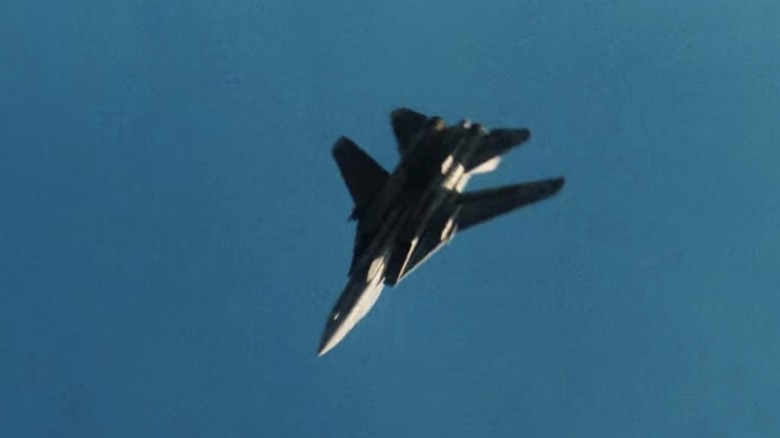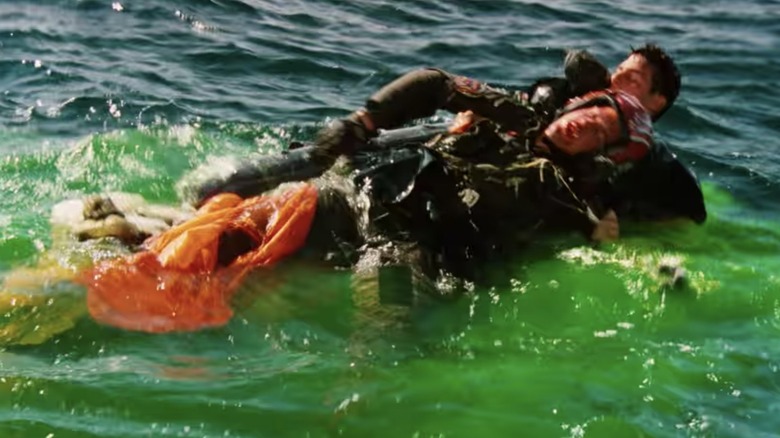The Plot Point In Top Gun The Navy Wouldn't Approve
When Paramount Pictures' "Top Gun" came out in 1986, it received some mixed reviews but became a commercial hit, eventually raking in $357 million worldwide (per Box Office Mojo) and becoming that year's biggest moneymaker. This was due to certain elements that thrilled moviegoers, including the aerial scenes that impressed Roger Ebert, the soundtrack that resonated with the likes of Den of Geek, and the fact that, as The Atlantic theorized in a retrospective, "Top Gun" remains an optimistic fulfillment of the promise of America. Arrogant yet personable Maverick (Tom Cruise) is like the rugged young country himself, undergoing an epic hero's journey.
That's reflected clearly in this thrilling, patriotic story of Navy pilots, which couldn't have been done so effectively without the involvement of the Department of Defense (DoD) and the military branches that it oversees. Still, "Top Gun," which was inspired by an article on Naval pilots from 1983, wasn't exactly known for its realism — Mark Vizcarra, director of the documentary "Tomcat Tales, said as much to the New York Post. "The first movie was fake," he admitted. "When they are flying upside down, canopy to canopy, and the fly-bys — the moment anyone would do that in the Navy, you would get your wings pulled."
So it's not like the Navy's involvement dampened some of the film's most memorable moments. However, there was at least one situation that the Navy didn't want to be depicted on screen, and the movie's producers listened.
The Navy wouldn't approve of Goose's death scene as a mid-air collision
The military has long been involved in Hollywood, to the benefit of both the movie-making industry and the armed services that protect the U.S. According to The Los Angeles Times, this relationship allows producers access to equipment, personnel, and locations you might not otherwise be able to see. It also allows the DoD some control over how the military is depicted in films seen by current enlisted troops as well as U.S. taxpayers. In the case of the original "Top Gun," producers paid the military $1.8 million for the use of a Naval air station, aircraft carriers, planes, and pilots (via Time).
As you may expect, though, the contrasting needs of different organizations may occasionally lead to some conflicts between the producers' vision and what the military is willing to allow. One of the movie's pivotal moments becomes an example of this. About an hour into "Top Gun," Maverick's best friend and wingman Goose (Anthony Edwards) dies in a tragic accident during a training session.
Originally, the scene was set to involve a fatal mid-air collision between aircraft. Stars and Stripes cited a Time Magazine piece from 1986 that alleged how the Navy felt there were too many mid-air collisions, thus necessitating some changes to the script. The result was just as devastating — maybe even more so, as the accident as depicted was so unexpected and seemingly random.
That scene was an important part of Maverick's emotional journey
In the final scene, the pilots are trying to get a lock on instructor Jester's (Michael Ironside) plane, but the rivalry between Maverick and Iceman (Val Kilmer) leads to some dangerous actions. After entering Iceman's jetwash, Maverick and Goose's plane suffers a flameout of both engines, leading to a flat spin that sends them toward the ocean. This forces them to eject, but when they do, Goose hits his canopy on the way out. The impact kills him before he even makes it into the water.
Whether it was meant to be realistic or not, however, that very effective death scene served as the turning point in the film. "Goose's journey is wonderfully tragic because you like him so much. You're like, 'Why does he have to die?' But in that form of storytelling, you have to make your hero suffer and overcome," Anthony Edwards told Yahoo!, calling his role an "emotional speed bump" in Maverick's journey. And the death of Goose is sure to have continuing effects, as Maverick encounters his son in "Top Gun: Maverick," which debuts this May.


